Orbea
Orbea melanantha (Schltr.) Bruyns
Family:
Common names: short-lobed brown carrion flower, black or dark flowered caralluma (Eng.); kort-lob bruin aasblom (Afr.)
Plant Attributes:
Plant Type:
SA Distribution:
Soil type:
Flowering season:
PH:
Flower colour:
Aspect:
Gardening skill:
Special Features:
Horticultural zones
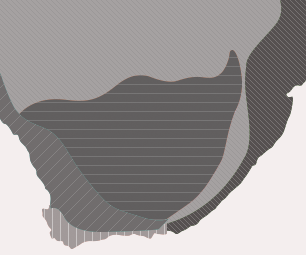
Orbea lutea (N.E.Br.) Bruyns subsp. lutea
Family:
Common names: yellow carrion flower (Eng.); geelaasblom, ghaap, gwaap, aasblom, kopseerblom, slang-gwaap (Afr.).
Plant Attributes:
Plant Type:
SA Distribution:
Soil type:
Flowering season:
PH:
Flower colour:
Aspect:
Gardening skill:
Special Features:
Horticultural zones

Orbea Haw.
Family:
Common names: carrion flower ( Eng. ); aasblom, bokhoring (Afr.)
Species
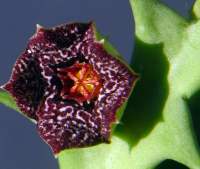
O. carnosa (Stent) Bruyns subsp. keithii (R.A.Dyer) Bruyns is stoloniferous and grows to a height of 60 mm. This plant has very prominent marginal teeth and small, fleshy flowers, which appear successively between the stem angles from October to January.
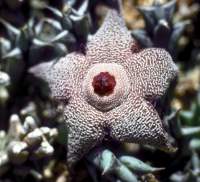
O. cooperi (N.E.Br.) L.C.Leach was formerly described in the genus Stultitia. It is widespread in the Eastern Cape, extending north-westwards through the western Free State into the Northern Cape. The plant has erect or ascending branches, up to 50 mm tall. One to three flowers arise from the sessile inflorescence near the base of the stems. The flowers are flattish, with a deep reddish colour and a lighter central annulus.
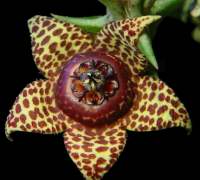
O. elegans Plowes is the most recently described species. It occurs on the south-eastern foothills of the Blouberg in Limpopo Province. The flower morphology is extremely distinct, differing from other species in the handsome (elegans ), spotted corolla with its dark purplish-maroon raised annulus. The species is currently listed as Critically Endangered (CR) on the Red Data List.
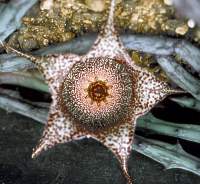
O. hardyi (R.A.Dyer) Bruyns is endemic to the northern parts of South Africa, from the Soutpansberg in Limpopo to about Pilgrim's Rest in Mpumalanga, growing in deep shade and humus-rich littered pockets of soil. It is extremely difficult to detect when not in flower. The sprawling, perennial, mottled stems can reach a length of 0.3 m, branching low down near the base. Flowering is in late summer, December to March, when one to four flowers are borne successively near the upper parts of the stems. The corolla tube is shallow-flattish, with an annulus. The corolla lobes are yellowish to cream-coloured with numerous red markings and spots, becoming lighter towards the centre. This species was named in honour of D.S.Hardy who was a well-known horticulturist of especially succulent plants.
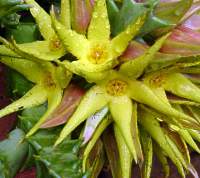
O. lutea (N.E.Br.) Bruyns subsp. lutea grows up to 100 mm high and, although usually erect, tends to sprawl when growing in shade. The stems are angled and also have prominent teeth. The flowers are produced in clusters of a few up to 17 and are carried at the base of the branches. The bright mustard-yellow to yellow corolla lobes have marginal vibratile hairs that dangle and move in the slightest breeze. The name is derived from the Latin word luteus which means yellow. Open flowers have a strong foul-smelling odour that attracts large numbers of fly pollinators. Flowering is mainly between December and February. This is the most widespread species of Orbea in South Africa, found in all the northern provinces, Free State , KwaZulu-Natal and the Northern Cape . The subspecies vaga (N.E.Br.) Bruyns has brown flowers.
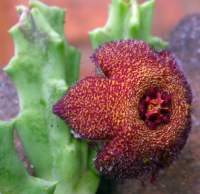
O. melanantha (Schltr.) Bruyns has somewhat shorter and thicker stems than O. lutea, with the marginal teeth less prominent. It also has a strong, foetid odour that attracts large numbers of carrion flies which are sometimes even deceived into depositing their eggs on the flowers. Flower colour varies from black to almost yellow, and flowering occurs from October to February. This species is found north of Pretoria in the Waterberg District and is abundant in the Polokwane area of Limpopo Province where it usually grows on rocky plains. It is also found in the Lydenburg-Middelburg areas in Mpumalanga. The epithet melanantha refers to the dark maroon, almost black flowers.
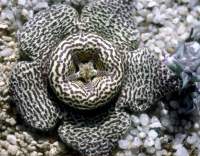
O. namaquensis (N.E.Br.) L.C.Leach has short, stout stems that are sometimes almost cylindrical. Is restricted to Namaqualand in the north-western corner of South Africa where it can become locally quite common. This species is closely related to O. variegata and mainly differs in the internal flower structures and the annulus. In the sterile state, the stems are indistinguishable from those of O. ciliata (which has a different distribution and is florally very different).
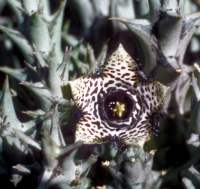
O. paradoxa (I.Verd.) L.C.Leach is a stoloniferous, dwarf perennial with angled branches, with prominent teeth along the angles. The small, yellowish, purple-mottled flowers are solitary or in pairs. The flower has a shallow tube and the margins of the corolla lobes have a distinct fringe of purple vibratile hairs. It usually flowers from November to January, but it also depends on rain. It has been recorded from arid bushveld around the Pongola area, extending further into KwaZulu-Natal .
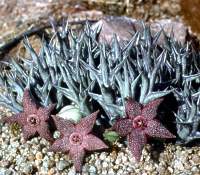
O. tapscottii (I.Verd.) L.C.Leach grows in large tufts of up to 100 mm in diameter, containing up to 60 fleshy branches and can reach a height of 120 mm. It also has prominent teeth that turn white with age. The solitary flowers develop successively from near the base of the branches. The corolla has a tube with a distinct annulus and is greenish yellow, mottled with dark brown, giving it an almost reddish appearance. It has a strong, foetid odour. The species flowers from December to March, again depending on the rainfall. It is restricted to drier regions of the central to northern parts of Limpopo Province and extends into Botswana. This species is closely related to O. cooperi. This orbea was named in honour of Sydney Tapscott who was a well-known plant-collector in Botswana and Zambia in the early twentieth century.
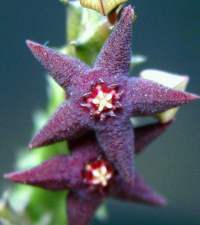
O. ubomboensis (I.Verd.) Bruyns has the smallest flowers in the genus. It has small, rather slender, tuft-forming stems and grows up to 40 mm high. A number of conical teeth are scattered along the angles. The flowers are dark maroon, up to 9 mm in diameter. They are borne in groups of two or three near the tips of the stems, from September to March. The plants are found from the Lebombo Mountains in the south along the eastern escarpment to the Soutpansberg and as far north as Zimbabwe. This well-known species was recently transferred to the genus Australluma.
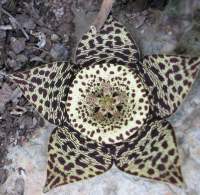
O. variegata (L.) Haw. is probably the most well-known of all the species, having been in cultivation the longest. As it was one of the first South African stapeliads to be cultivated in Europe, many hybrids have been grown, most of them described as distinct species at some stage. Many of these hybrids are still in cultivation world-wide. The species grows under a variety of conditions. It originally comes from the winter-rainfall area of the Western Cape, mainly along the coastal belt. It grows actively during winter and spring. Growers should let the soil dry out between waterings and should feed the plants during the active growing season. Soil has to be wel-drained and rich in organic matter. This species is regarded as an alien invader in the southern parts of Australia.
Plant Attributes:
Plant Type:
SA Distribution:
Soil type:
Flowering season:
PH:
Flower colour:
Aspect:
Gardening skill:
Special Features:
Horticultural zones






Rate this article
Article well written and informative
Rate this plant
Is this an interesting plant?
Login to add your Comment
Back to topNot registered yet? Click here to register.